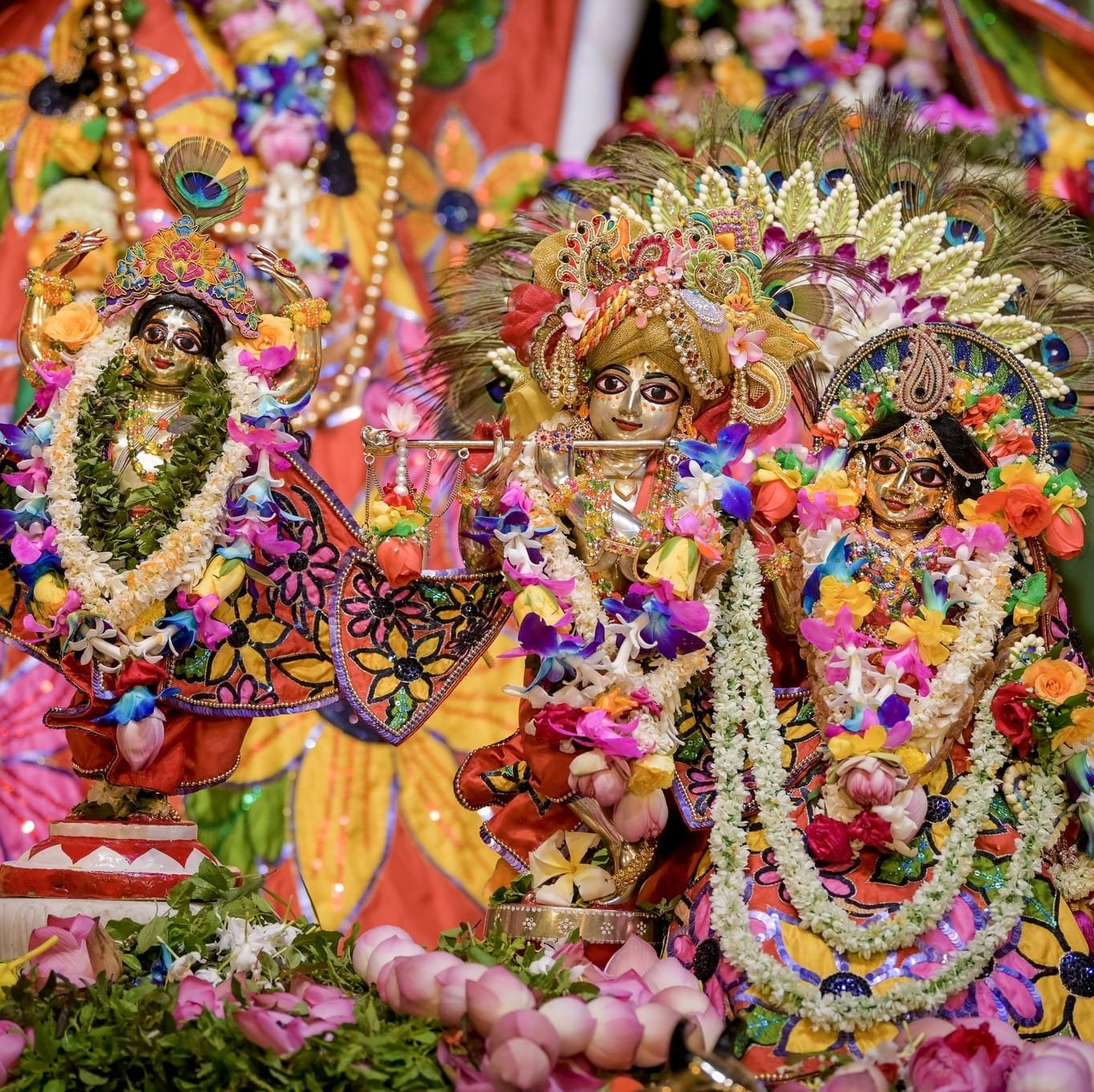
Chota Radha Madhava & Sri Mayapur Chandra
Information – The Chota Radha Madhava Deities on the altar are taken out in procession during festivals, such as Jhulana-yatra (the swing festival) and the boat festival. These deities have been worshipped in Mayapur since 1972.
Information – It was that same year, 1972, that small Radha- Madhava came to Māyāpur. “There were three sets of deities made, paid for by one of the Birlas,” Bhavananda says. “One set is in Boston, and these Deities here in Māyāpur, small Rādhā-Mādhava, were the ones Śrila Prabhupāda took on pandals. These Deities were the ones he sang Jaya Rādhā- Madhava to for the first time, then he said, ‘Keep Them here always.’ We built Them a little shed and Jananivāsa started worshipping Them.”
(‘Article Full of Abundant Grace’ by Braja Sevaki dasi, Mayapur Magazine 2006)
Śrīla Sanātana Gosvāmī has explained the various meanings of the word mādhava as follows: Mādhava normally indicates Kṛṣṇa to be “the Lord, who is the consort of the goddess of fortune, Lakṣmī.” This name also implies that Lord Kṛṣṇa descended in the dynasty of Madhu. Since the spring season is also known as Mādhava, it is understood that as soon as Lord Kṛṣṇa entered the Vṛndāvana forest, it automatically exhibited all the opulences of spring, becoming filled with flowers, breezes and a celestial atmosphere. Another reason Lord Kṛṣṇa is known as Mādhava is that He enjoys His pastimes in madhu, the taste of conjugal love.
(SB 10.15.2 purport)
The beauty of Kṛṣṇa’s smile is the sweetest feature of all. His smile is like a full moon that spreads its rays throughout the three worlds—Goloka Vṛndāvana, the spiritual sky of the Vaikuṇṭhas, and Devī-dhāma, the material world. Thus Kṛṣṇa’s shining beauty spreads in all ten directions.
(CC Madhya 21.139)
In the beginning of Caitanya-caritāmṛta it is said that Lord Caitanya appeared in order to taste the feelings Rādhārāṇī felt upon seeing Kṛṣṇa. Kṛṣṇa Himself could not understand the ecstatic feelings of Rādhārāṇī toward Him, and therefore He desired to accept the role of Rādhārāṇī and thereby taste these feelings. Lord Caitanya is Kṛṣṇa with the feelings of Rādhārāṇī; in other words, He is a combination of Rādhā and Kṛṣṇa. It is therefore said, śrī-kṛṣṇa-caitanya rādhā-kṛṣṇa nahe anya. By worshiping Śrī Caitanya Mahāprabhu alone, one can relish the loving affairs of Rādhā and Kṛṣṇa together. One should therefore try to understand Rādhā-Kṛṣṇa not directly but through Śrī Caitanya Mahāprabhu and through His devotees.
(CC Adi 13.43 purport)
Radharani is also Krishna. There is no difference between the energy and the energetic. Without energy there is no meaning to energetic, and without the energetic there is no meaning to energy. Similarly, without Radha there is no meaning to Krishna, and without Krishna there is no meaning to Radha. Therefore the Vaishnava philosophy first of all worships the internal pleasure potency of the Supreme Lord. It is always said, “Radha Krishna.” Although the author is going to explain the intricacies of this pleasure potency, he first of all utters the name of Radha. Similarly, those who worship the Name of Narayan first of all utter the name of Lakshmi; those who are worshippers of Lord Rama first of all utter the name of Sita. Sita Rama, Radha Krishna,Lakshmi Narayan—the potency always first.
Radha and Krishna are One. When Krishna desires to enjoy pleasure He manifests Himself. The spiritual exchange of love affair is the display of the internal potency or pleasure potency of Krishna. We say “when” Krishna desires, although just when He did desire, we cannot say. But we speak in this way because in conditional life we take it that everything has some beginning. In the Absolute, or spiritual life, there is no beginning; there is no end. But in order to understand that Radha and Krishna are One, and that They become divided, that question “When?” automatically comes to be asked. When Krishna desired to enjoy His pleasure potency, He manifested Himself in the separate Form of Radharani. Again, when Krishna wanted to understand Himself through the agency of Radha, They became united—and that unification is called Lord Chaitanya.
(Teachings of Lord Chaitanya Introduction)
Kṛṣṇa is one, but when Kṛṣṇa wants to enjoy, He must expand His pleasure potency. That is Rādhārāṇī. Rādhā kṛṣṇa-praṇaya-vikṛtir. Kṛṣṇa cannot enjoy anything material. The original spiritual potency, pleasure potency, is Rādhārāṇī. So first of all He expanded, then again He combined together. That is Śrī Kṛṣṇa Caitanya Mahāprabhu. This is the study of the Gosvāmī. Rādhā kṛṣṇa-praṇaya-vikṛtir hlādinī.
Therefore Caitanya Mahāprabhu is given seat along with Kṛṣṇa. He's combination of Rādhā and Kṛṣṇa. We may not misunderstand that Caitanya Mahāprabhu is . . . imitating Caitanya Mahāprabhu, there are so many so-called avatāras. But this is approved by the śāstra. Kṛṣṇa-varṇaṁ tviṣākṛṣṇam (SB 11.5.32). Caitanya Mahāprabhu is Kṛṣṇa, same category, kṛṣṇa-varṇaṁ. Just like we say varṇa: brāhmaṇa varṇa, kṣatriya varṇa, śūdra varṇa, vaiśya varṇa. Varṇa means the same category, varṇa. Or kṛṣṇa-varṇaṁ means who is always describing Kṛṣṇa. Just like Caitanya Mahāprabhu is passing on the road, He's chanting,
kṛṣṇa kṛṣṇa kṛṣṇa kṛṣṇa kṛṣṇa kṛṣṇa kṛṣṇa he
kṛṣṇa kṛṣṇa kṛṣṇa kṛṣṇa kṛṣṇa kṛṣṇa kṛṣṇa he
kṛṣṇa kṛṣṇa kṛṣṇa kṛṣṇa kṛṣṇa kṛṣṇa pāhi māṁ
(CC Madhya 7.96)
Therefore kṛṣṇa-varṇaṁ is He; iti kṛṣṇa. Kṛṣṇa is describing Himself: kṛṣṇa-varṇaṁ tviṣākṛṣṇam. But by His complexion, He is not black—very fair complexion.
(730306 - Lecture BG 10.01-3 - Calcutta)
Bhaktivinod Thakur has written this song “Jaya Radha Madhava”. The official name for this song is Jaya Radha Krsna Giti. Bhaktivinoda Thakura glories Shree Krishna and Sri Radha, Vrindavan and all the inhabitants of the Vrindavana Dham, Yamuna river, Yasoda, Govardan Hill. Hari Govinda has performed many pastimes in Vrindavava just for the pleasure of Sri Radhey and the Braj Vasis. This song is sung by Srila Prabhupada before commencing his lectures.
(1)
jaya rādhā-mādhava kuñja-bihārī
gopī-jana-vallabha giri-vara-dhārī
(2)
yaśodā-nandana braja-jana-rañjana
yāmuna-tīra-vana-cārī
TRANSLATION
1) Krsna is the lover of Radha. He displays many amorous pastimes in the groves of Vrndavana, He is the lover of the cowherd maidens of Vraja, and the holder of the great hill named Govardhana.
2) He is the beloved son of mother Yasoda, the delighter of the inhabitants of Vraja, and He wanders in the forests along the banks of the River Yamuna!
